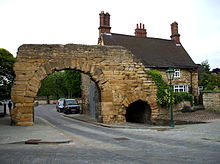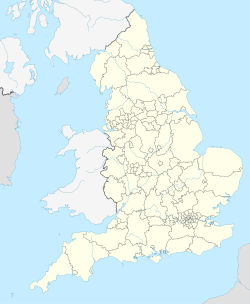
Back Lindum Catalan Lindum Colonia German Lindum Colonia Spanish Lindum Italian Lindum Colonia LLD Lindum Colonia Dutch Lindum Colonia Serbo-Croatian
 The Newport Arch is a surviving part of the north gate to the Upper City. | |
| Alternative name | Lindum, Colonia Domitiana Lindensium |
|---|---|
| Location | Lincoln, Lincolnshire, England |
| Region | Britannia |
| Coordinates | 53°14′02″N 00°32′17″W / 53.23389°N 0.53806°W |
| Type | Settlement |
| History | |
| Builder | Domitian |
| Founded | Around 80 AD |
| Abandoned | End of the 5th century |
| Periods | Roman Imperial |
Lindum Colonia was the Roman settlement which is now the City of Lincoln in Lincolnshire. It was founded as a Roman Legionary Fortress during the reign of the Emperor Nero (58–68 AD) or possibly later.[1] Evidence from Roman tombstones suggests that Lincoln was first garrisoned by the Ninth Legion Hispana, which probably moved from Lincoln to found the fortress at York around c. 71 AD. Lindum was then garrisoned by the Second Legion Adiutrix, which then went on to Chester in 77–78 AD.[2]
Probably under the reign of Domitian and most likely after 86 AD, the fortress became a colonia, a settlement for retired soldiers sanctioned by the Emperor.[3] The colonia now developed and a second enclosure, often referred to as the Lower Colonia was added between the Upper Colonia and the River Witham. Evidence has been uncovered for the Forum, baths, temples, buildings and shops of the colonia which was enclosed by walls. The walls of the Upper Colonia started to be built in the earlier part of the 2nd century,[4] while the Lower Colonia was walled in either the late 2nd or early 3rd centuries. The Roman settlement also spread to the south of the river Witham in the area known as the Wigford. In the early 3rd century with the re-organisation of the Roman Empire, a case can be made that Lindum Colonia had become the provincial capital of Britannia Secunda and possibly a Bishop from Lincoln was present at the Council of Arles in 314 AD.[5] In the 4th century Lincoln continued to develop and there is increasing evidence for Christianity. After the departure of the Romans in the 5th century Lindum declined in size and population, although archaeological evidence suggests some degree of continuity.
© MMXXIII Rich X Search. We shall prevail. All rights reserved. Rich X Search

